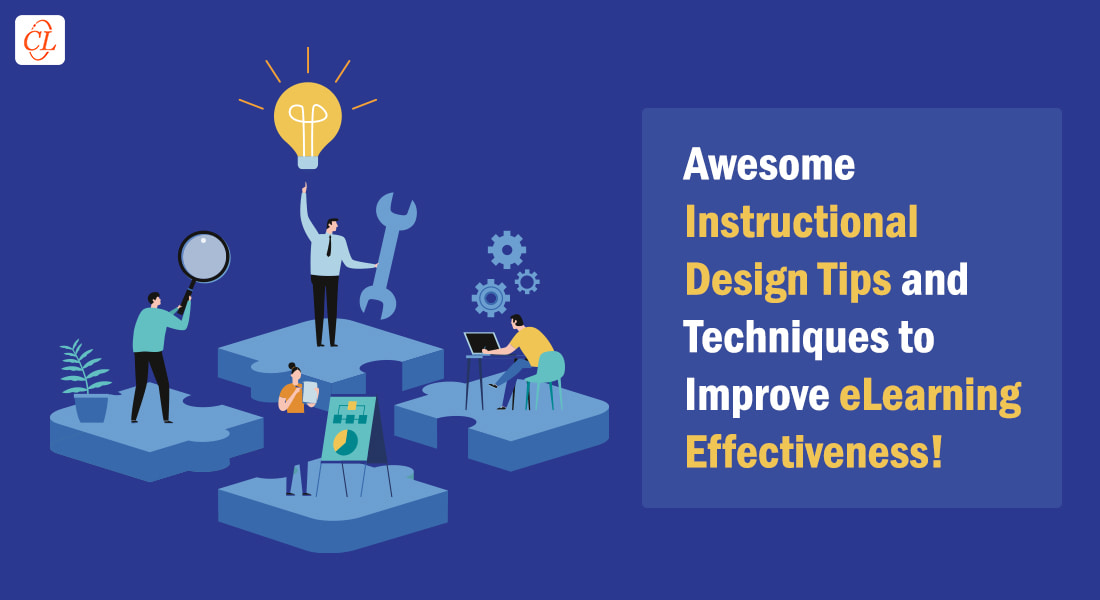Top 4 Instructional Design Techniques and How They Can Help Improve eLearning Effectiveness

In eLearning, the use of instructional design principles is crucial. The absence of a physical teacher in an online learning environment is substituted by collaborative learning and quick access to a wealth of publicly available information. However, making use of this setting and the resources offered is difficult and might hinder learning if it is not based on a strong instructional design strategy. The secret to a successful eLearning course is appropriate to the design. Learning objectives are simple to reach and complete when courses are developed using instructional design principles.
A comprehensive blueprint for how a subject should be taught is called an instructional strategy. Like any other approach, instructional design starts with clearly defining goals, deciding the steps that must be done to attain these goals, and utilizing a range of tools, resources, and strategies to do so.
Let’s look at several instructional strategies in this blog post and see how they might be helpful in various training scenarios.
What Instructional Design Strategies Make for a Successful eLearning Experience?
Here are the top 4 Instructional Design Strategies to Make eLearning Memorable:
- Simulations
- Game-Based Learning
- Storytelling
- Case Study
The Top 5 Instructional Design Techniques and How They Affect eLearning Effectiveness
1. Simulations
Simulations in mimic the environment and conditions of real-life to allow learners to explore, learn, and practice, thus preparing them for on-the-job tasks they are likely to encounter. They provide learners a risk-free platform to practice and lead to a reduction in the overall training time and cost, not to mention the costly repercussions associated with tasks that go haywire.
The setting and circumstances of real-life are mimicked via simulations in eLearning to provide learners the chance to explore, learn, and practice while becoming ready for any potential on-the-job activities. They give learners a risk-free practice environment and cut down on training time and expense overall, not to mention the expensive consequences of activities gone awry.
With the use of simulations, learners can grow more comfortable using new software, operating intricate and heavy equipment, or handling complex products in the real world. Before going live, learners may test the system out in a fail-safe setting, which:
- Increases their comfort level utilizing the system
- Arms them with the information they can immediately put to use in the workplace
- Reduces expensive mistakes and downtime in real-world situations
Types of training it is recommended for:
- ERP/Software training – which will enable learners to master the system depending on their unique responsibilities.
- Product training – to make sales representatives and service professionals adept at using the product
- Safety training – which will assist service staff in becoming comfortable with using various equipment
To ensure that eLearning courses stand out, explore the fundamentals of instructional design!
2. Game-based Learning
Game-based learning, often known as GBL, employs game components to impart certain knowledge or meet particular learning objectives. It all comes down to knowing what your learners need to learn and providing value for them in a game setting. Consider role-playing video games. These games provide players the chance to see the world from someone else’s point of view and experience it firsthand.
GBL is a sort of gameplay that has established learning objectives while still enabling the learners to enjoy themselves. Games are often just for pleasure.
In game-based learning, the training course is created as a game to achieve certain learning objectives or impart particular skills to learners following their learning needs.
Even while games are typically made (and played) only for recreation, they may be employed in a learning environment when they conform to predetermined learning objectives while still allowing learners to have fun. Game-based learning includes the following components:
- The context and setting of the game
- Rules, scores, levels
Types of training it is recommended for:
- Information training – to assist students to comprehend the significance of data security and make sure they follow the rules
- Code of conduct training – teaches participants how to spot and stay out of murky waters while interacting with customers and vendors.
- Sales/Product training – to assist sales representatives in learning and boosting their levels of motivation via competition.
3. Storytelling
The latent knowledge of company culture, values, and management systems may be effectively transferred with stories. They provide learners the freedom to experiment, create views, pass judgment, and build their attitudes and beliefs. To aid knowledge transfer, storytelling employs the following techniques:
- War stories (personal experiences, stories from the field
- Scenarios
- Case studies
- Anecdotes
Types of training it is recommended for:
- New hire orientation, which provides information on the organization’s vision, objectives, and various departments.
- Anti-harassment training promotes a happy workplace by ensuring that all workers comprehend and practice inclusion and equality at work.
- Change management training – to allay workers’ fears about change and illustrate the advantages of the new software through case studies.
4. Case Study
A case study can cover the whole course and can be used in exams to gauge learners’ understanding of the material covered. It can be made up or based on actual events. A case study provides a setting and context for learning and aids learners in instantly applying what they have learned to achieve the intended outcomes, such as improving circumstances or making decisions.
Elements involved:
- The case (or the issue being addressed, including the scene and the people)
- The queries or scenarios that learners must consider and respond to
Types of training it is recommended for:
- Process training – to assist learners in comprehending the shortcomings of the present system and coming up with fixes or a new system.
- Compliance training – to assist learners in understanding why an incident occurred, what can be done to prevent similar incidents in the future, and what should be done if they do occur.
- Leadership training – to assist new leaders in understanding the significance of their role and assist them in mentoring subordinates, providing feedback, building credibility, etc.
Parting Thoughts
These instructional design strategies not only help your learners retain what they learn but also keep them engaged and happy. Since effective on-the-job implementation depends on learner engagement, every firm strives to achieve this goal.
While we discussed using instructional design principles to create unforgettable eLearning experiences, wouldn’t you be curious to learn how to launch these courses quickly? This free eBook is one you shouldn’t pass up! “Quick Rollout with Rapid eLearning Design.”




![Top 3 Instructional Design Strategies That Pair Perfectly with Rapid eLearning [SlideShare]](https://blog.commlabindia.com/hubfs/Imported_Blog_Media/instructional-design-strategies-rapid-elearning-slideshare.png)
